Global Travel Information
River Mekong, Vietnam/Laos/etc.
The Mighty Mekong: Lifeline of Southeast Asia
The Mekong River, one of the world’s great waterways, flows through six countries—China, Myanmar, Laos, Thailand, Cambodia, and Vietnam—before emptying into the South China Sea. Stretching over 4,350 kilometers (2,700 miles), it is the lifeblood of Southeast Asia, sustaining millions of people, diverse ecosystems, and rich cultural traditions. This article explores the Mekong’s significance in Vietnam and Laos, its ecological and economic importance, the challenges it faces, and the efforts to preserve its future.
The Mekong’s Journey Through Laos and Vietnam
The Mekong begins its journey in the Tibetan Plateau, carving through rugged landscapes before entering Southeast Asia. In Laos, the river is both a source of sustenance and a defining geographical feature. The country’s capital, Vientiane, sits on its banks, while the legendary "4,000 Islands" (Si Phan Don) region in southern Laos showcases the river’s breathtaking beauty, with cascading waterfalls and tranquil villages.
Further downstream, the Mekong enters Vietnam, where it forms the Mekong Delta, a vast, fertile region often called the "Rice Bowl of Vietnam." This delta, covering over 40,000 square kilometers, is a labyrinth of rivers, swamps, and islands, supporting agriculture, fisheries, and a unique way of life.
Economic and Ecological Importance
1. Agriculture and Fisheries
The Mekong Delta produces more than half of Vietnam’s rice and a significant portion of its seafood exports. Farmers rely on the river’s seasonal floods, which deposit nutrient-rich silt, making the land exceptionally fertile. Similarly, in Laos, the river supports rice paddies and vegetable farms, particularly in rural communities.
Fishing is another critical industry. The Mekong is home to over 1,000 fish species, including the giant Mekong catfish and the endangered Irrawaddy dolphin. Many families depend on daily catches for food and income.
2. Hydropower and Energy
Laos, often called the "Battery of Southeast Asia," has heavily invested in hydropower dams along the Mekong. Projects like the Xayaburi Dam and Don Sahong Dam generate electricity for domestic use and export to Thailand and Vietnam. However, these dams have sparked controversy due to their environmental and social impacts.
3. Transportation and Trade
The Mekong serves as a vital trade route. In Laos, boats transport goods between remote villages and cities. In Vietnam, the delta’s intricate waterways are highways for commerce, with floating markets like Cai Rang and Phong Dien offering a vibrant glimpse into river-based economies.

Challenges Facing the Mekong
Despite its importance, the Mekong is under severe threat from human activities and climate change.
1. Dam Construction and Sediment Blockage
Dams disrupt fish migration and trap sediment, which is essential for maintaining fertile delta soils. Scientists warn that without this sediment, the Mekong Delta could sink by several centimeters per year, increasing vulnerability to rising sea levels.
2. Overfishing and Biodiversity Loss
Illegal fishing, habitat destruction, and pollution have led to declining fish stocks. The Mekong giant catfish, once abundant, is now critically endangered.
3. Climate Change and Salinization
Rising temperatures and erratic rainfall affect water flow. In Vietnam’s delta, saltwater intrusion has rendered some farmlands unusable, forcing farmers to abandon rice fields.
Conservation and Sustainable Development
Efforts to protect the Mekong are underway:
- The Mekong River Commission (MRC), comprising Cambodia, Laos, Thailand, and Vietnam, promotes sustainable water management.
- Eco-Tourism Initiatives in Laos and Vietnam encourage responsible travel, supporting local communities while preserving ecosystems.
- Alternative Farming Techniques, such as shrimp-rice rotation in Vietnam, help farmers adapt to salinity.
Conclusion
The Mekong is more than a river—it is a cultural symbol, an economic engine, and an ecological treasure. Balancing development with conservation is crucial to ensuring that future generations can continue to rely on its waters. As climate pressures and industrialization intensify, regional cooperation and innovative solutions will determine whether the Mekong remains Southeast Asia’s lifeline or becomes another cautionary tale of environmental degradation.
Would you like any sections expanded or additional details on specific aspects of the Mekong?
相关文章
- Elbe River Botanical Gardens: Flowers & Plants Along the Banks
- Elbe River Zoos & Aquariums: Family Fun Near the River
- Elbe River Amusement Parks: Rides with River Views
- Elbe River Camping Spots: Pitch a Tent by the Water
- Elbe River Glamping Sites: Luxury Camping Along the Banks
- Elbe River RV Parks: Stay in Your Camper Near the River
- Elbe River B&Bs: Cozy Accommodations with a Personal Touch
- Elbe River Hostels: Budget Stays for Young Travelers
- Elbe River Business Travel Guide: Meetings & Events Near the Water
- Elbe River Conference Venues: Spaces with River Views
发表评论
评论列表
- 这篇文章还没有收到评论,赶紧来抢沙发吧~


